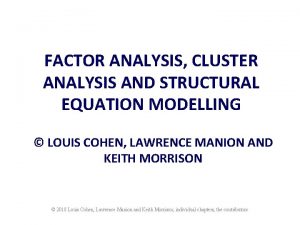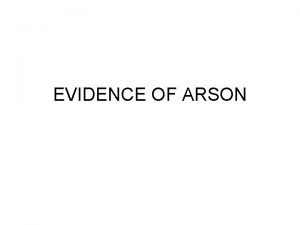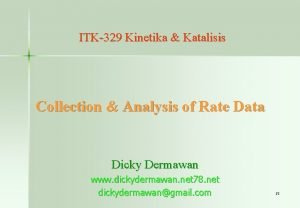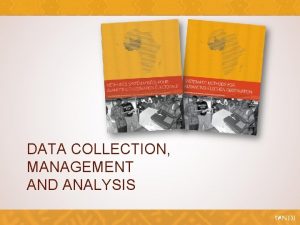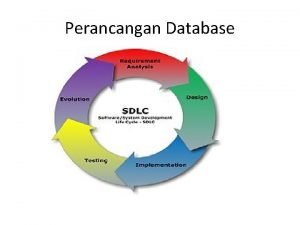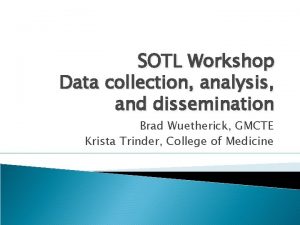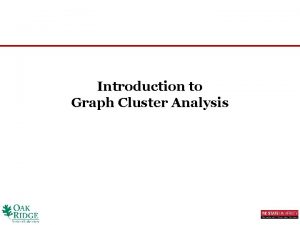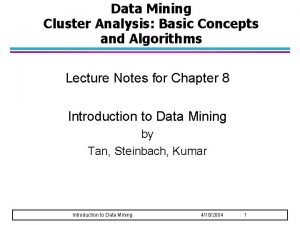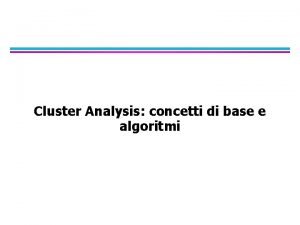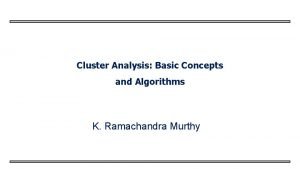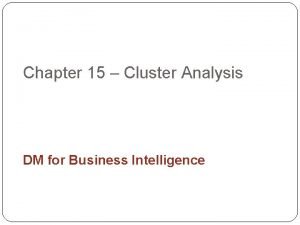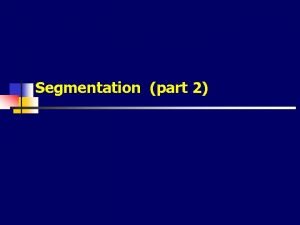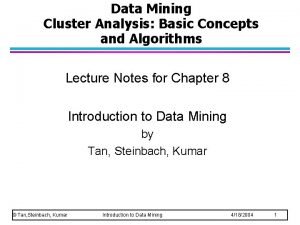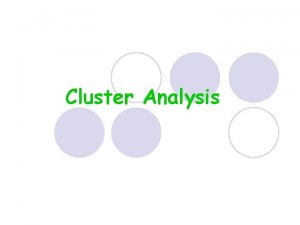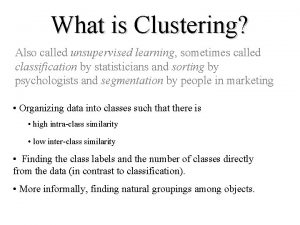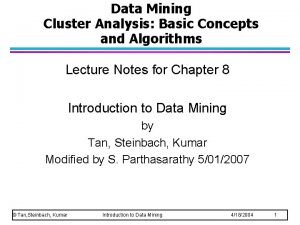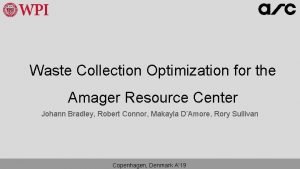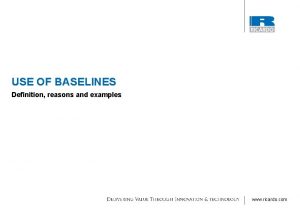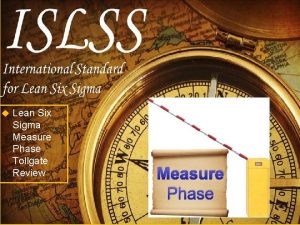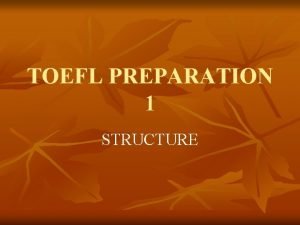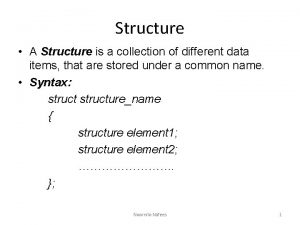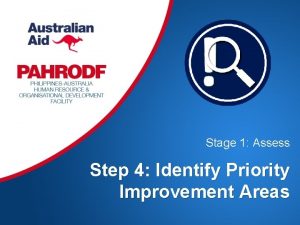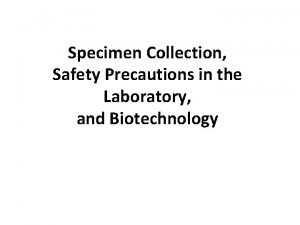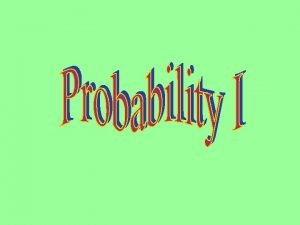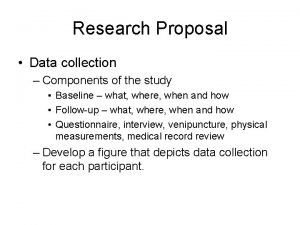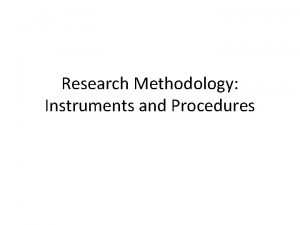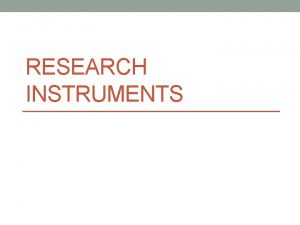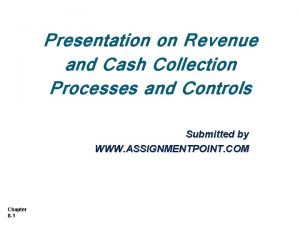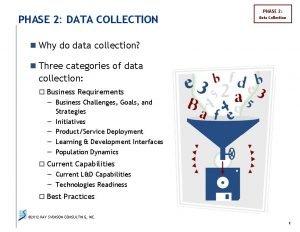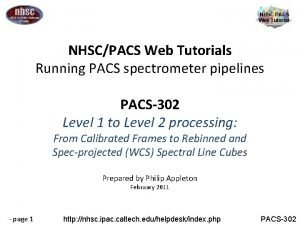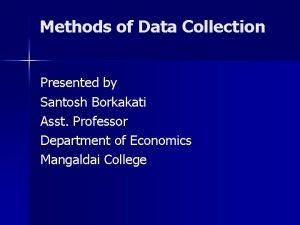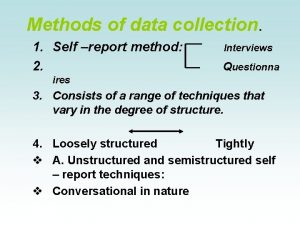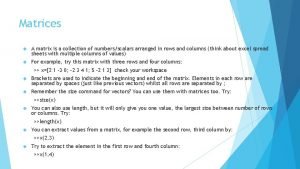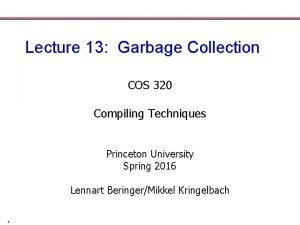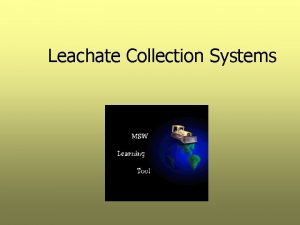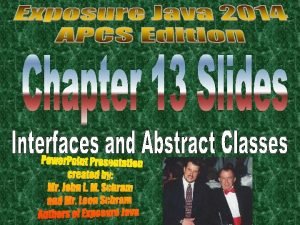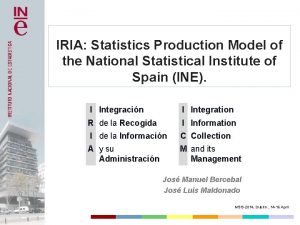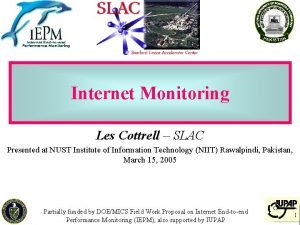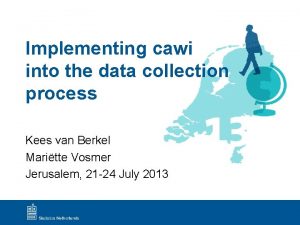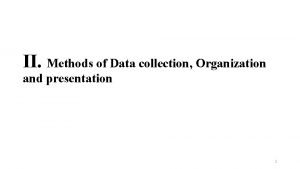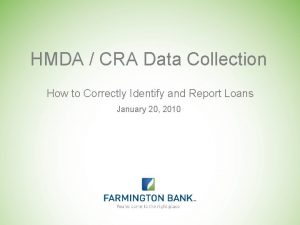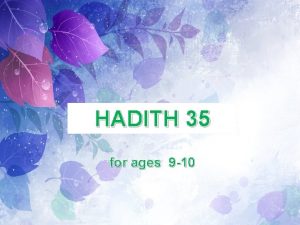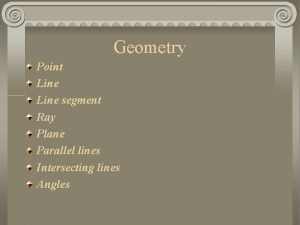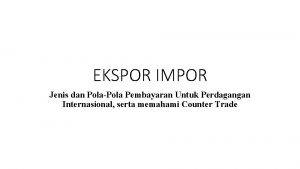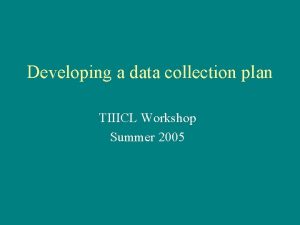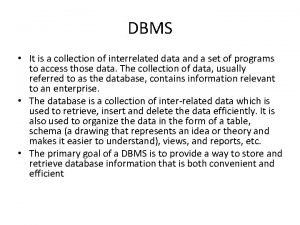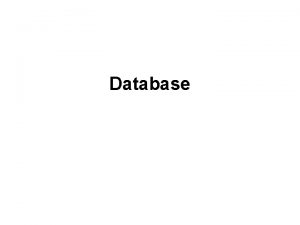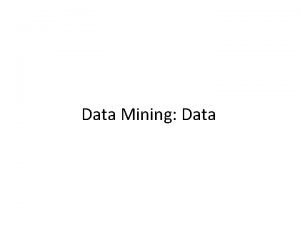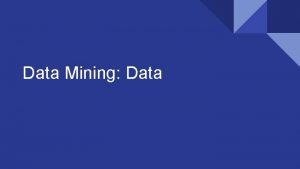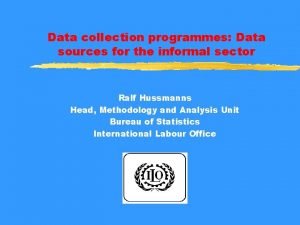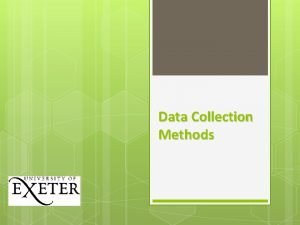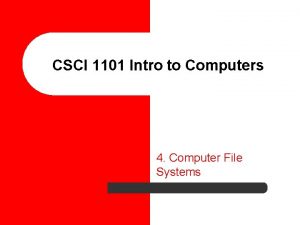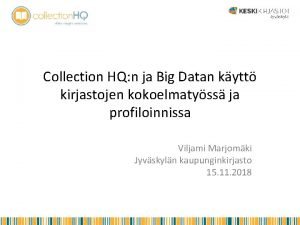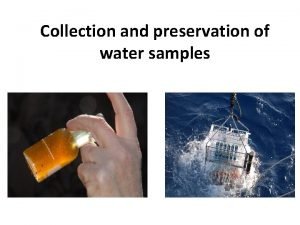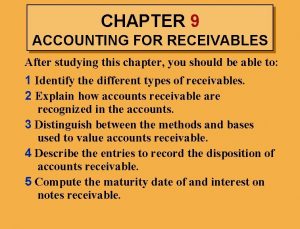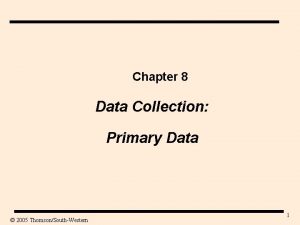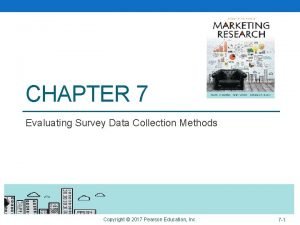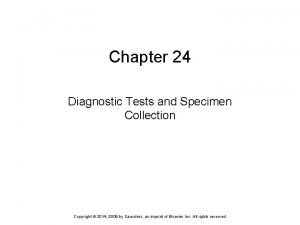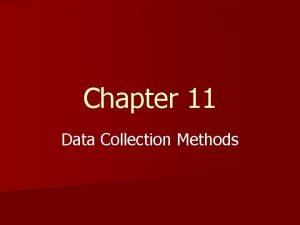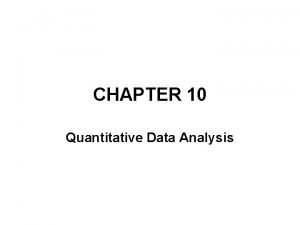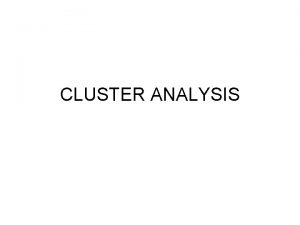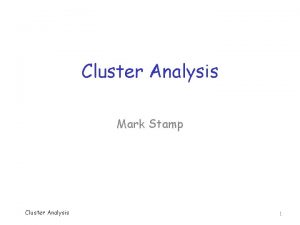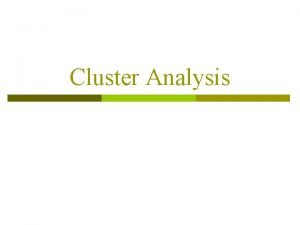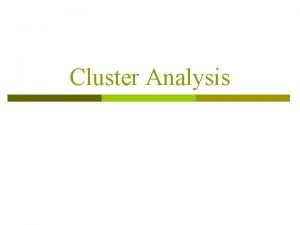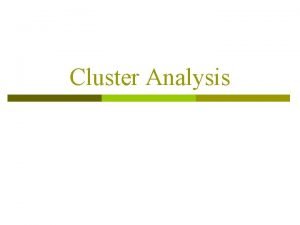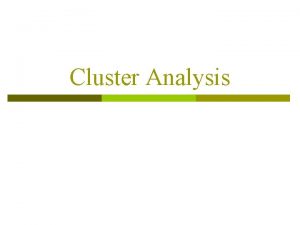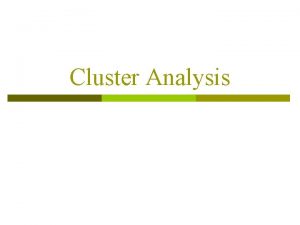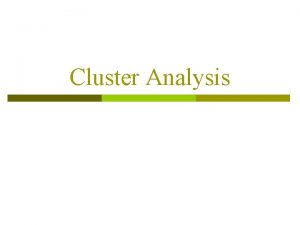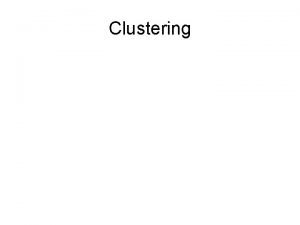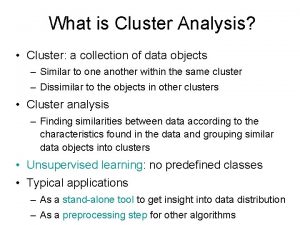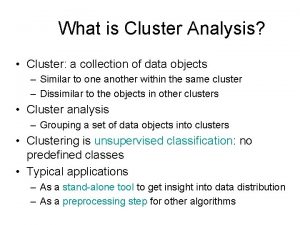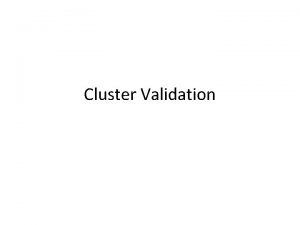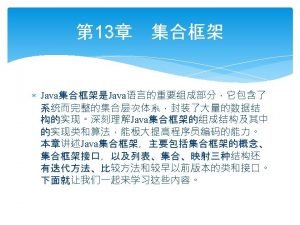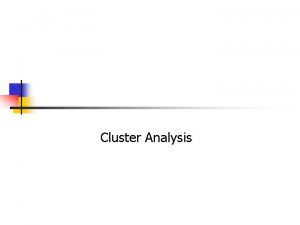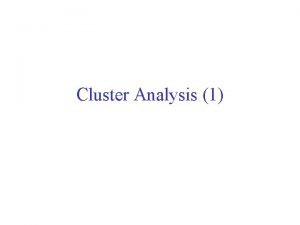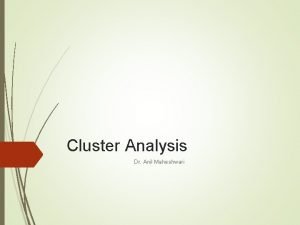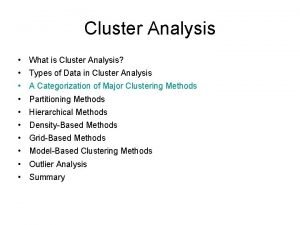What is Cluster Analysis Cluster a collection of








































































































- Slides: 104


What is Cluster Analysis? Cluster: a collection of data objects n n Similar to one another within the same cluster Dissimilar to the objects in other clusters Cluster analysis n Grouping a set of data objects into clusters Clustering is unsupervised classification: no predefined classes Typical applications n n As a stand-alone tool to get insight into data distribution As a preprocessing step for other algorithms Α. Νανόπουλος, Γ. Μανωλόπουλος: Εισαγωγή στην Εξόρυξη & Αποθ. Δεδομένων 2

General Applications of Clustering Pattern Recognition Spatial Data Analysis n create thematic maps in GIS by clustering feature spaces n detect spatial clusters and explain them in spatial data mining Image Processing Economic Science (especially market research) WWW n Document classification n Cluster Weblog data to discover groups of similar access patterns Α. Νανόπουλος, Γ. Μανωλόπουλος: Εισαγωγή στην Εξόρυξη & Αποθ. Δεδομένων 3

What Is Good Clustering? A good clustering method will produce high quality clusters with n high intra-class similarity n low inter-class similarity The quality of a clustering result depends on both the similarity measure used by the method and its implementation. The quality of a clustering method is also measured by its ability to discover some or all of the hidden patterns. Α. Νανόπουλος, Γ. Μανωλόπουλος: Εισαγωγή στην Εξόρυξη & Αποθ. Δεδομένων 4

Notion of a Cluster can be Ambiguous How many clusters? Six Clusters Two Clusters Four Clusters Α. Νανόπουλος, Γ. Μανωλόπουλος: Εισαγωγή στην Εξόρυξη & Αποθ. Δεδομένων 5

Types of Clusters: Well-Separated Clusters: n A cluster is a set of points such that any point in a cluster is closer (or more similar) to every other point in the cluster than to any point not in the cluster. 3 well-separated clusters Α. Νανόπουλος, Γ. Μανωλόπουλος: Εισαγωγή στην Εξόρυξη & Αποθ. Δεδομένων 6

Types of Clusters: Density-Based Density-based n n A cluster is a dense region of points, which is separated by low-density regions, from other regions of high density. Used when the clusters are irregular or intertwined, and when noise and outliers are present. 6 density-based clusters Α. Νανόπουλος, Γ. Μανωλόπουλος: Εισαγωγή στην Εξόρυξη & Αποθ. Δεδομένων 7

Types of Clusters: Conceptual Clusters Shared Property or Conceptual Clusters n Finds clusters that share some common property or represent a particular concept. . 2 Overlapping Circles Α. Νανόπουλος, Γ. Μανωλόπουλος: Εισαγωγή στην Εξόρυξη & Αποθ. Δεδομένων 8

Requirements of Clustering in Data Mining Scalability Ability to deal with different types of attributes Discovery of clusters with arbitrary shape Minimal requirements for domain knowledge to determine input parameters Able to deal with noise and outliers Insensitive to order of input records High dimensionality Incorporation of user-specified constraints Interpretability and usability Α. Νανόπουλος, Γ. Μανωλόπουλος: Εισαγωγή στην Εξόρυξη & Αποθ. Δεδομένων 9

Chapter 8. Cluster Analysis What is Cluster Analysis? Types of Data in Cluster Analysis A Categorization of Major Clustering Methods Partitioning Methods Hierarchical Methods Density-Based Methods Grid-Based Methods Model-Based Clustering Methods Outlier Analysis Summary Α. Νανόπουλος, Γ. Μανωλόπουλος: Εισαγωγή στην Εξόρυξη & Αποθ. Δεδομένων 10


Measure the Quality of Clustering Dissimilarity/Similarity metric: Similarity is expressed in terms of a distance function, which is typically metric: d(i, j) There is a separate “quality” function that measures the “goodness” of a cluster. The definitions of distance functions are usually very different for interval-scaled, boolean, categorical, ordinal and ratio variables. Weights should be associated with different variables based on applications and data semantics. It is hard to define “similar enough” or “good enough” n the answer is typically highly subjective. Α. Νανόπουλος, Γ. Μανωλόπουλος: Εισαγωγή στην Εξόρυξη & Αποθ. Δεδομένων 12





Binary Variables A contingency table for binary data Object j Object i Simple matching coefficient (invariant, if the binary variable is symmetric): Jaccard coefficient (noninvariant if the binary variable is asymmetric): Α. Νανόπουλος, Γ. Μανωλόπουλος: Εισαγωγή στην Εξόρυξη & Αποθ. Δεδομένων 17

Dissimilarity between Binary Variables Example n n n gender is a symmetric attribute the remaining attributes are asymmetric binary let the values Y and P be set to 1, and the value N be set to 0 Α. Νανόπουλος, Γ. Μανωλόπουλος: Εισαγωγή στην Εξόρυξη & Αποθ. Δεδομένων 18

Variables of Mixed Types A database may contain all the types of variables n symmetric binary, asymmetric binary, nominal, ordinal, interval One may use a weighted formula to combine their effects. n n n f is binary or nominal: dij(f) = 0 if xif = xjf , or dij(f) = 1 o. w. f is interval-based: use the normalized distance f is ordinal or ratio-scaled w compute ranks rif and w and treat zif as interval-scaled Α. Νανόπουλος, Γ. Μανωλόπουλος: Εισαγωγή στην Εξόρυξη & Αποθ. Δεδομένων 19

Chapter 8. Cluster Analysis What is Cluster Analysis? Types of Data in Cluster Analysis A Categorization of Major Clustering Methods Partitioning Methods Hierarchical Methods Density-Based Methods Grid-Based Methods Outlier Analysis Summary Α. Νανόπουλος, Γ. Μανωλόπουλος: Εισαγωγή στην Εξόρυξη & Αποθ. Δεδομένων 20

Major Clustering Approaches Partitioning algorithms: Construct various partitions and then evaluate them by some criterion Hierarchy algorithms: Create a hierarchical decomposition of the set of data (or objects) using some criterion Density-based: based on connectivity and density functions Grid-based: based on a multiple-level granularity structure Model-based: A model is hypothesized for each of the clusters and the idea is to find the best fit of that model to each other Α. Νανόπουλος, Γ. Μανωλόπουλος: Εισαγωγή στην Εξόρυξη & Αποθ. Δεδομένων 21

Chapter 8. Cluster Analysis What is Cluster Analysis? Types of Data in Cluster Analysis A Categorization of Major Clustering Methods Partitioning Methods Hierarchical Methods Density-Based Methods Grid-Based Methods Outlier Analysis Summary Α. Νανόπουλος, Γ. Μανωλόπουλος: Εισαγωγή στην Εξόρυξη & Αποθ. Δεδομένων 22

Partitioning Algorithms: Basic Concept Partitioning method: Construct a partition of a database D of n objects into a set of k clusters Given a k, find a partition of k clusters that optimizes the chosen partitioning criterion n Global optimal: exhaustively enumerate all partitions n Heuristic methods: k-means and k-medoids algorithms n k-means (Mac. Queen’ 67): Each cluster is represented by the center of the cluster n k-medoids or PAM (Partition around medoids) (Kaufman & Rousseeuw’ 87): Each cluster is represented by one of the objects in the cluster Α. Νανόπουλος, Γ. Μανωλόπουλος: Εισαγωγή στην Εξόρυξη & Αποθ. Δεδομένων 23







K-means example, step 3 k 1 Y Move each cluster center to the mean of each cluster k 2 k 3 X Α. Νανόπουλος, Γ. Μανωλόπουλος: Εισαγωγή στην Εξόρυξη & Αποθ. Δεδομένων 30

K-means example, step 4 Reassign points Y closest to a different new cluster center k 1 Q: Which points are reassigned? k 3 k 2 X Α. Νανόπουλος, Γ. Μανωλόπουλος: Εισαγωγή στην Εξόρυξη & Αποθ. Δεδομένων 31







K-means variations K-medoids – instead of mean, use medians of each cluster Mean of 1, 3, 5, 7, 95 is 205 n Mean of 1, 3, 5, 7, 1009 is 5 is n Median of 1, 3, 5, 7, 1009 n Median advantage: not affected by extreme values n For large databases, use sampling Α. Νανόπουλος, Γ. Μανωλόπουλος: Εισαγωγή στην Εξόρυξη & Αποθ. Δεδομένων 38






Απόσταση ομάδων p 1 Similarity? p 2 p 3 p 4 p 5 . . p 1 p 2 p 3 p 4 n n n MIN MAX Group Average Distance Between Centroids Ward’s Method (squared error) p 5 . . . Proximity Matrix Α. Νανόπουλος, Γ. Μανωλόπουλος: Εισαγωγή στην Εξόρυξη & Αποθ. Δεδομένων 44













CURE: Another Hierarchical Approach Uses a number of points to represent a cluster Representative points are found by selecting a constant number of points from a cluster and then “shrinking” them toward the center of the cluster Cluster similarity is the similarity of the closest pair of representative points from different clusters Α. Νανόπουλος, Γ. Μανωλόπουλος: Εισαγωγή στην Εξόρυξη & Αποθ. Δεδομένων 57


BIRCH (1996) Birch: Balanced Iterative Reducing and Clustering using Hierarchies, by Zhang, Ramakrishnan, Livny (SIGMOD’ 96) Incrementally construct a CF (Clustering Feature) tree, a hierarchical data structure for multiphase clustering n n Phase 1: scan DB to build an initial in-memory CF tree (a multi-level compression of the data that tries to preserve the inherent clustering structure of the data) Phase 2: use an arbitrary clustering algorithm to cluster the leaf nodes of the CF-tree Scales linearly: finds a good clustering with a single scan and improves the quality with a few additional scans Weakness: handles only numeric data, and sensitive to the order of the data record. Α. Νανόπουλος, Γ. Μανωλόπουλος: Εισαγωγή στην Εξόρυξη & Αποθ. Δεδομένων 59

Clustering Feature Vector Clustering Feature: CF = (N, LS, SS) N: Number of data points LS: Ni=1=Xi SS: Ni=1=Xi 2 CF = (5, (16, 30), (54, 190)) (3, 4) (2, 6) (4, 5) (4, 7) (3, 8) Α. Νανόπουλος, Γ. Μανωλόπουλος: Εισαγωγή στην Εξόρυξη & Αποθ. Δεδομένων 60

CF Tree Root B=7 CF 1 CF 2 CF 3 CF 6 L=6 child 1 child 2 child 3 child 6 Non-leaf node CF 1 CF 2 CF 3 CF 5 child 1 child 2 child 3 child 5 Leaf node prev CF 1 CF 2 CF 6 Leaf node next prev CF 1 CF 2 CF 4 Α. Νανόπουλος, Γ. Μανωλόπουλος: Εισαγωγή στην Εξόρυξη & Αποθ. Δεδομένων next 61



Characteristics of Spatial Data Sets • Clusters are defined as densely populated regions of the space • Clusters have arbitrary shapes, orientation, and non-uniform sizes • Difference in densities across clusters and variation in density within clusters • Existence of special artifacts (streaks) and noise The clustering algorithm must address the above characteristics and also require minimal supervision. Α. Νανόπουλος, Γ. Μανωλόπουλος: Εισαγωγή στην Εξόρυξη & Αποθ. Δεδομένων 64


Chameleon: Steps Preprocessing Step: Represent the Data by a Graph n Given a set of points, construct the k-nearest-neighbor (k -NN) graph to capture the relationship between a point and its k nearest neighbors n Concept of neighborhood is captured dynamically (even if region is sparse) Phase 1: Use a multilevel graph partitioning algorithm on the graph to find a large number of clusters of wellconnected vertices n Each cluster should contain mostly points from one “true” cluster, i. e. , is a sub-cluster of a “real” cluster Α. Νανόπουλος, Γ. Μανωλόπουλος: Εισαγωγή στην Εξόρυξη & Αποθ. Δεδομένων 66

Chameleon: Steps … Phase 2: Use Hierarchical Agglomerative Clustering to merge subclusters n Two clusters are combined if the resulting cluster shares certain properties with the constituent clusters n Two key properties used to model cluster similarity: w Relative Interconnectivity: Absolute interconnectivity of two clusters normalized by the internal connectivity of the clusters w Relative Closeness: Absolute closeness of two clusters normalized by the internal closeness of the clusters Α. Νανόπουλος, Γ. Μανωλόπουλος: Εισαγωγή στην Εξόρυξη & Αποθ. Δεδομένων 67













Characteristics of Spatial Data Sets • Clusters are defined as densely populated regions of the space • Clusters have arbitrary shapes, orientation, and non-uniform sizes • Difference in densities across clusters and variation in density within clusters • Existence of special artifacts (streaks) and noise The clustering algorithm must address the above characteristics and also require minimal supervision. Α. Νανόπουλος, Γ. Μανωλόπουλος: Εισαγωγή στην Εξόρυξη & Αποθ. Δεδομένων 80
























 Landsat collection 1 vs collection 2
Landsat collection 1 vs collection 2 Documentary payment
Documentary payment Kmo test
Kmo test Ice lined refrigerator ppt
Ice lined refrigerator ppt Define data collection method
Define data collection method Collection and analysis of rate data
Collection and analysis of rate data Data collection management and analysis
Data collection management and analysis Database system development
Database system development Collection analysis dissemination of data
Collection analysis dissemination of data Site:slidetodoc.com
Site:slidetodoc.com Maximal clique
Maximal clique Minitab cluster analysis
Minitab cluster analysis Data mining clustering
Data mining clustering Global shelter cluster cos'è
Global shelter cluster cos'è Cluster analysis basic concepts and algorithms
Cluster analysis basic concepts and algorithms Cluster analysis basic concepts and algorithms
Cluster analysis basic concepts and algorithms Cluster analysis basic concepts and algorithms
Cluster analysis basic concepts and algorithms Exploratory cluster analysis
Exploratory cluster analysis Cluster analysis market segmentation
Cluster analysis market segmentation Cluster analysis basic concepts and algorithms
Cluster analysis basic concepts and algorithms Sas cluster analysis example
Sas cluster analysis example What is cluster analysis
What is cluster analysis Cluster analysis in alteryx
Cluster analysis in alteryx Cluster analysis basic concepts and algorithms
Cluster analysis basic concepts and algorithms What is harvest?
What is harvest? Website is a collection of *
Website is a collection of * Lindsay waste disposal
Lindsay waste disposal Amager resource center
Amager resource center Windchill managed collection
Windchill managed collection Collection unit 4
Collection unit 4 Kind of quantitative research
Kind of quantitative research Tollgate review
Tollgate review Tonbridge and malling refuse
Tonbridge and malling refuse Folding fans arrive in europe
Folding fans arrive in europe Agricultural research service culture collection
Agricultural research service culture collection Thai digital collection
Thai digital collection Structure is a collection of
Structure is a collection of Liz owns stock in nar heating/cooling and cilla shipping
Liz owns stock in nar heating/cooling and cilla shipping Priority improvement areas template
Priority improvement areas template Role of nurse in specimen collection slideshare
Role of nurse in specimen collection slideshare What is power set
What is power set Finding answer through data collection
Finding answer through data collection Polysemy synonymy, hyponymy and antonymy
Polysemy synonymy, hyponymy and antonymy Sampoorna data collection format
Sampoorna data collection format It is the collection of all possible outcomes
It is the collection of all possible outcomes Data collection in research proposal
Data collection in research proposal Instruments in research methodology
Instruments in research methodology What is research instrument
What is research instrument Collection matrix receivables management
Collection matrix receivables management Define data collection method
Define data collection method Cash collection process flow chart
Cash collection process flow chart Data collection phase
Data collection phase Autism curriculum encyclopedia
Autism curriculum encyclopedia Pacs tutorial
Pacs tutorial Nh+collection+roma+centro
Nh+collection+roma+centro Pantry audit example
Pantry audit example Self report method
Self report method A matrix is a collection of
A matrix is a collection of Cheney garbage collection
Cheney garbage collection Leachate collection system diagram
Leachate collection system diagram Collection hierarchy java
Collection hierarchy java Iria ine
Iria ine Network data collection at slac
Network data collection at slac Incremental garbage collection
Incremental garbage collection Cawi data collection
Cawi data collection Hadith 6 of an nawawi
Hadith 6 of an nawawi Collection organization and presentation of data
Collection organization and presentation of data Cra data collection worksheet
Cra data collection worksheet Certificate iii in pathology collections
Certificate iii in pathology collections Hadith 38 of annawawis collection
Hadith 38 of annawawis collection Hadith 35 of annawawis collection
Hadith 35 of annawawis collection Lesson of hadith 18
Lesson of hadith 18 Grenada waste disposal
Grenada waste disposal Collection of points along a straight path
Collection of points along a straight path Garbage collection in java
Garbage collection in java Garbage collection strategies
Garbage collection strategies Elit chocolate origin
Elit chocolate origin Countertrade adalah
Countertrade adalah Data collection plan
Data collection plan Dash is collection of interrelated data
Dash is collection of interrelated data Interview method of data collection
Interview method of data collection A structured collection of data:
A structured collection of data: Collection of data objects
Collection of data objects Discretization and binarization in data mining
Discretization and binarization in data mining Informal data collection
Informal data collection A major advantage of primary data collection is that
A major advantage of primary data collection is that Instrumentation in research example
Instrumentation in research example A named collection of data on a storage medium
A named collection of data on a storage medium A computer system is a collection of
A computer system is a collection of Setout setback collection
Setout setback collection Collection hq
Collection hq Facilitated collection
Facilitated collection Collection development policy
Collection development policy Dussart flask water sampler diagram
Dussart flask water sampler diagram Quick assets formula
Quick assets formula Data analysis qualitative and quantitative
Data analysis qualitative and quantitative Basal state blood collection
Basal state blood collection Accounting for receivables chapter 9
Accounting for receivables chapter 9 Interview method of data collection
Interview method of data collection A disadvantage of the mall intercept interview method is
A disadvantage of the mall intercept interview method is Average collection period ratio
Average collection period ratio Chapter 24 diagnostic tests and specimen collection
Chapter 24 diagnostic tests and specimen collection A collection of utility programs designed to maintain
A collection of utility programs designed to maintain Observational data collection method
Observational data collection method Statistical treatment of data example
Statistical treatment of data example


